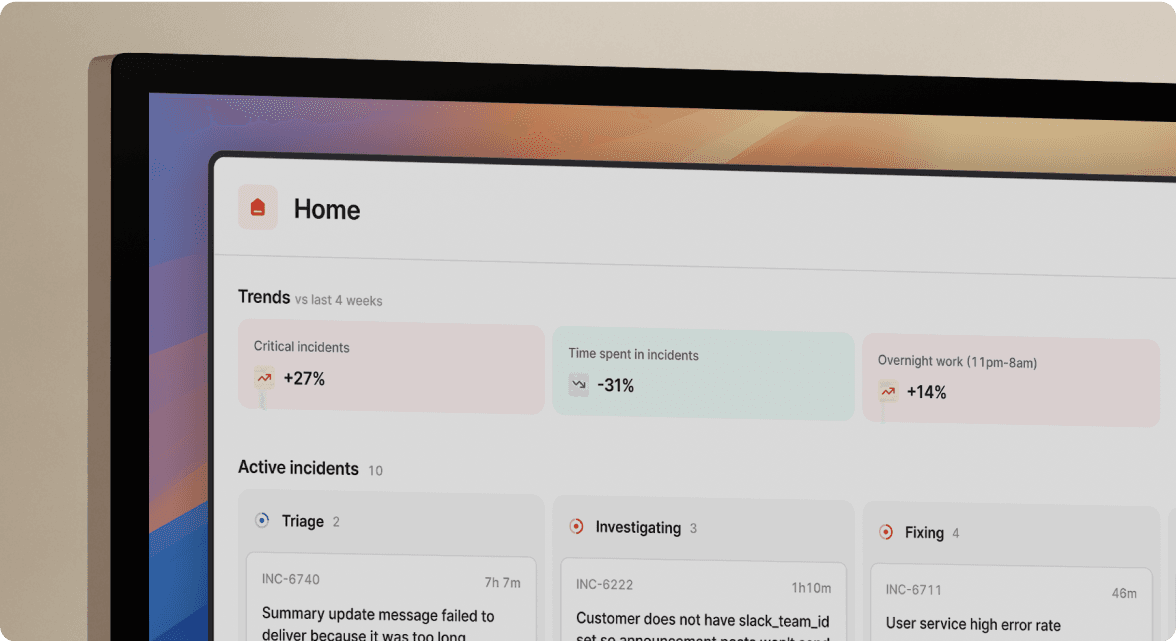Summary templates
September 5, 2023

Summary templates can be used to encourage responders to provide relevant and consistent information across all of your incidents. This further helps to reduce the cognitive load on responders and lowers the barrier for newcomers to respond to incidents.
They can be defined for each individual incident type, as types such as “Operations” and “Security” are likely to have very different defaults.
You can go to Settings → Incident Types → Summary template to set this up now.
Customizable names for debrief

The terminology for postmortems and debriefs isn’t yet standardized across the industry. We’ve optimized for familiarity by using the most standard terminology, but we know that others prefer different terms to best describe them.
If you use a different word to represent a debrief meeting, you can now change the default. We'll then use your preferred name across our entire platform. Additionally, you can configure the default title and description we use when pre-filling a debrief event.
This is now available in Settings → Debriefs → Customise debrief name.
Additional polish for workflows, conditions, variables and expressions

We recently released a new look for workflows, for a much more intuitive experience. We have now rolled out these improvements across the rest of our platform. Some of the highlights from these improvements are:
- When you use an expression in a workflow step, we now show you the whole expression in the sidebar instead of just the name, so you can understand your steps more easily
- We also show this fancy new expressions view in other contexts, such as policies
- Whenever you’re inserting variables or adding conditions, you’ll get the same new ‘popover’ experience - keeping things smooth
- When rich text is being edited, we use our new and improved styling
Catalog colors and icons

We’ve swapped out red and gray for pink and cyan, and added orange alongside a few extra icons. This prevents any confusion, as red could be mistakenly interpreted as broken and grey interpreted as inactive.
Exposing Jira problems

We now expose any errors that have been encountered when creating a Jira issue for an incident. This makes it clear why that failure has happened, as well as a pointer as to how it happened. This gives you more observability and control, reducing confusion, and improving the time to fix any problems.
🚀 What else we shipped
Improvements
- Our Google Calendar integration no longer requires you to choose subscribed calendars; we’ll detect any debrief event which invites the connected user instead
- We’ll now automatically attach a Google Calendar event as a debrief if it contains your customized word for a “debrief”
- Streamlined settings for Nudges: If you ask for a nudge to only be delivered once, we won’t ask you for a repeat interval
- We now use the new variable selector across incident.io, making it easier to add conditions and use variables
- Upon creating a catalog entry, you'll now be seamlessly directed to your newly-created item
- When assigning learning flow tasks, we now automatically invite users to the incident Slack channel if they're not already in the channel
- Improving insights: The "last 3 months" filter will no longer include the current month by default
- Retrospective incidents are now filtered out from activity heatmap on the dashboard homepage
- Dropdowns for Jira users are now significantly faster
Bug fixes
- Fixed an issue where conditions picker could disappear when you try to construct an expression
- Fixed a bug where you couldn’t edit the ‘summary’ quick action
- Hide the 'Escalate' button in Slack if not bot account is configured to escalate to PagerDuty
- The Jira issue template editor no longer resets changes you've made to the default template name
- Stop suggesting auto-created Google Meet events as debrief events
- When exporting follow-ups, we'll now automatically retry fetching newly created issues if Jira's API fails
- When declaring a status page maintenance window, we'll now pre-fill the maintenance template
- Prevent the reporter role from being manually set, as this is populated automatically for you
- Fix on-call exports from producing blank CSVs
So good, you’ll break things on purpose
Ready for modern incident management? Book a call with one of our experts today.

We’d love to talk to you about
- All-in-one incident management
- Our unmatched speed of deployment
- Why we’re loved by users and easily adopted
- How we work for the whole organization



